Dewberries, Resurrections, and the Art of Turkey Herding
Stepping into the world below our knees
In summer’s depth, when the grass is breast high in hot meadows, and the spring’s opening salvo of common forbs stand tall to flower and seed as nodding parasols of Queen Anne’s Lace, tough stalks of chicory, and bronze pillars of feral parsnip, a new landscape emerges, outside our common perception. It appears to those who carefully observe the undulations of the prairie –a rustling– perpendicular to the wind’s rhythm, as unseen life wends its way through burgeoning stands of stemmy grass and prickling bramble vine.
Although the thickening fields appear open, uneventful, and even barren to the overstimulated and itinerant travelers, untrained in their appreciation of grasslands, who might shuttle across our prairies by automobile (may as well be flying over it) in pursuit of snow-capped mountains or crystalline springs, those of us with sense enough to stick to the lowlands will know that this unassuming swath of humble grasses swarms with life –mammalian, avian, reptilian, arthropodal, fungal and bacterial— a great deal of it below knee height, stirring down in the tangle of grasses and forbs.
On still, sharp days, you might catch the glint of rhythmically fluttering grass, caused by the ambulations of grasshopper sparrows, or perhaps a ground nesting bobolink. A smooth, rapid disturbance indicates the meanderings of a prairie kingsnake, while the wavering of a single stem gives away the perching place of a young locust. But my favorite subtle sign in the animate verdure is the heavy rustling of a hen turkey, trailed by the tiny susurrations of newly hatched poults.
For some years now, I have kept back some hens from our turkey flock to breed to our deeply ostentatious tom, Jellybean. All winter and spring, he does his tom turkey thing: drumming, dancing, strutting, and gobbling. Once springtime arrives and the hens become receptive to his showmanship and amorous advances, he is allowed one more performance, that which is his sole purpose, as described in earlier editions of this almanac. The hens venture out into the relative cover of thatch, brambles, and young grasses.
As the hen returns daily to lay her eggs in these hidden depressions in the grass (their normal preference for shelter is to roost in trees) she will sit for longer and longer, until she has decided she has quite enough eggs to raise, and begins incubating them with her warm body. Inevitably, some hens will return to rampaged nests, or less fortunately, become victims to predation themselves. As late spring turns to early summer and each hen begins her instinctual nest-tending habit, Jellybean and I look out into that growing, wavering banner of verdant cover and wonder whether they’ll return, or if they’re gone for good.
It is now late –nearly too late– in the turkey brooding season to expect any hen who has gone off into the prairie for nesting to come back safe and intact. Each year of encouraging natural turkey brooding, up until this point, has been fraught with raccoon-eaten eggs and fox-slaughtered hens. I have done my best to improve practices on our end to encourage safe nesting, but with the hens often choosing sites outside of the range of our working dogs, the results have yielded no turkey babies. That is, until now.
Most of our hens, having failed to successfully set eggs naturally, circle back to their summertime climes in our sprawling barnyard-orchard to spend the long days pecking at detritus under the hedgerow and dust bathing in the dry shade of the poultry barn. It appeared that I had lost one of our Royal Palm hen— some neighbors even reported a trail of large white feathers leading out to the known location of a fox den. The hen in question I’d scarcely seen for the past two weeks, and I’d chalked it up as yet another loss to predation, that disheartening but nonetheless fair form of natural taxation extracted from us by the beasts whose habitat we ourselves have extracted and encroached upon. But as the climbing vegetation and open prairie-scape fills in with exuberant growth and budding stems and dense jumbles of herbage, I have seen that telltale rustle, with its subsequent patter of trailing sparkles in the shining and sun-drenched swards of grass– a turkey hen resurrected from the limbo of the brood-nest, chirping and squawking unseen in the lively world of stem and soil.
With the proper range of warmth and humidity, resurrections abound. In our garden, the withering of the bottom three leaves on garlic plants portends the unearthing of great, pungent bulbs. The long dormant seeds of paw paws I’d sown and forgotten and declared deceased have suddenly popped, setting their radicles within the embrace of giving earth and raising aloft their first leafless natal appendages. In fields where late summer fires immolated every dry stalk and spent bloom, a burgeoning carpet of partridge pea salutes the widened arc of sunlight, their phoenix seeds softened for sprouting by the flame. Underlying the mosaic of reaching grasses and widening discs of coneflower and black-eyed susan, down in the stem-base of the prairie, the razored whips of dewberries that have pulled at my ankles and impeded my intrusion offer up their gift wherever our blades haven’t sliced in these past months.
Like so much of the world that is rich and teeming with vitality below our knees, the dewberry (Rubus aboriginum) is something we need to stand among to fully appreciate. A spiny network terminating in sweet, shining clusters of black juice, seed and sugar borne of summer sun and glacial till. They seem to thrive in areas where the sod is thin and weathered, armoring the vulnerable earth from the plodding activities trespassing, tool-using primates like me. By the summertime, the juicy drupes emerge and are eaten by light footed birds, stalking foxes, and bounding cottontails. And they are a delicacy among our turkey flocks both wild and domestic. Of course, the turkeys we raise seem to fall somewhere in between these binary distinctions.

I have much experience in herding flocks of heritage breed turkeys, and some advice on this art. I have directed flocks of turkeys with long wooden crooks (the hook end is for shaking them out of tree limbs), fiberglass fence posts, fluttering arms, rebar rods, and recently a bike pump. I actually learned that a bike pump with a squeaky seal makes a sound awfully similar to the nasal croaking of a doting hen turkey, and can be used to gather the attention of an unseen flock of poults, their heads springing from the dewy clumps of pasture grass when used. I have attempted to simulate calls both vocally and with the aid of box calls, chased birds alone or in tandem through bramble patches, vine-choked draws, broad open grassland and neighboring real estate.
As a prey animal, a turkey’s eyeballs are placed along the side of its head, allowing for a panoramic orientation to its surroundings, at the expense of depth perception. In some instances, it is best to drive the birds from behind using the flash of guide sticks from side to side, just within their visual periphery. Other times, a herd can be drawn towards a location by creating curiosity. They at first step forward apprehensively, craning their necks and rotating their heads at right angles to determine the nature of the far-off figure. If they can be coaxed or enchanted out of the impenetrable hedgerows and thickets far enough, a second party might be able to slip behind the flock quick enough to efficiently drive them towards the appropriate place. But nothing arouses more curiosity than the ripening carpet of dewberries down beneath the grass canopy, and so our poults take themselves on walkabouts well outside the quaint, human-engineered confines of their paddock.
Without nutritionally concentrated feeds available through modern agriculture, a young turkey can only survive the first act of her life by covering vast areas in search of tender forage, bugs, seeds, and wild fruit like the dewberry. Balancing the instinctual drive of our semi-domesticated flock against the safety and efficiency of providing free access to commercial grain by rotational pasturing our flock across appropriate habitat is a concept that turns out more complicated and labor intensive in practice than in theory, and each year I suddenly remember this, after it’s too late.
The drive to consume insects, a source for the basic, life-supporting amino acids that turkey poults need to thrive, is often insatiable. Phalanxes of turkey will comb swaths of grass in pursuit of beetles, moths, leafhoppers, grasshoppers, and flies, progressing farther and farther out in the prairie in a manner similar to human dove-hunting, flushing the fluttering bugs out of the vegetation where they can be pounced upon. Sometimes these flock formation widen until the group becomes separated from each other, and must be strategically reunited by a pair of herders with good communication skills and the ability to forgive each other later for words uttered in the heat of frustration.
And it is frustrating at times, so much so that I’ve sworn myself ready to sell off my enterprise at multiple moments these past days. Scattering hither and yon o’er cleft and hillock at the mere suggestion of predation offered by distant movement, our main flock, unanchored by the sense and instinct of an attending mother hen, flutters in disparate orientations, appearing like windswept leaves, or paper currency blowing out to field. Sometimes the whole group shows up in the hedge of ripening blackberries along our back footpath, or chirping and shitting on the foundation of our construction site. Other times they are silent and still in the dappled shade— somewhere undetermined. When an hour passes and I have not seen them in my serpentine meanderings along the broad, hot face of this slope, exhorting them with my passable imitation of gobbles and chirps, I begin to expect the worse, that they have somehow traipsed themselves into the waiting jaws of a fox, until the naughty troop of poults rises from out of a tall stand of sawtooth sunflower, or the shade of wild cherry.
I have even dealt with poults roosting some thirty or forty feet up in the old hedge tree on our fencerow this week, where they felt quite secure and impervious to my branch shaking and cussing. It wasn’t until I collected some pocketfuls of road gravel that I flung into the canopy like a threatening, inverted hailstorm that I was actually able to get them to gather back down on the earth and drive them home.
Our successful mother hen and her clutch of week-old poults is much less work to manage in some ways, though being able to drop off a small feeder and waterer in her remote resting spots without spooking her off with babies in tow can be a challenge. She often locates herself in an area near an evasion point of tall grass, but with an open view of here surroundings, higher up where she can scan the horizon for predators. Nearly every time I come to check on her, I find her seemingly alone, and begin to fear that her clutch has been lost. And while mortality was high early on, she invariably rises and clucks, and the tall grass shivers in response to the hurried tramping of tiny bird life.
From any distance across the ditch and along the drifting dust of gravel roads, this brushy, worn-down slope might appear barren to some, the economic value of our weeds as negligible in the eyes of agronomists when placed in context of the surrounding hillside dotted with neat, golden hay bales and chin-high corn. As summertime settles in for the long haul, clans of vacationing, tool-using primates fly past our plain, sleepy and unstimulating pocket of temperate North America, en route to the snow-capped peaks of distant national parks, the waiting saddle of lake-house jet skis and grand hubristic monuments carved into stone that will outlast our own species ‘til the sun explodes. None of them pass through purposely, and most do it at an altitude of 30,000 feet. I wonder, would their holiday reverie subside and give way to wonder if they were to exit their means of mechanical conveyance for a moment and stand quiet in this sea of grass? If for a moment, in their tactical sweatpants or American flag bikinis, divorced from the picture postcard world of destinations and leisure, if they too would see and feel the ecstatic rustling of the populous, biotic world below our knees, out standing in our field? I suppose if they could stand the ticks long enough, they might be rewarded with dewberries.


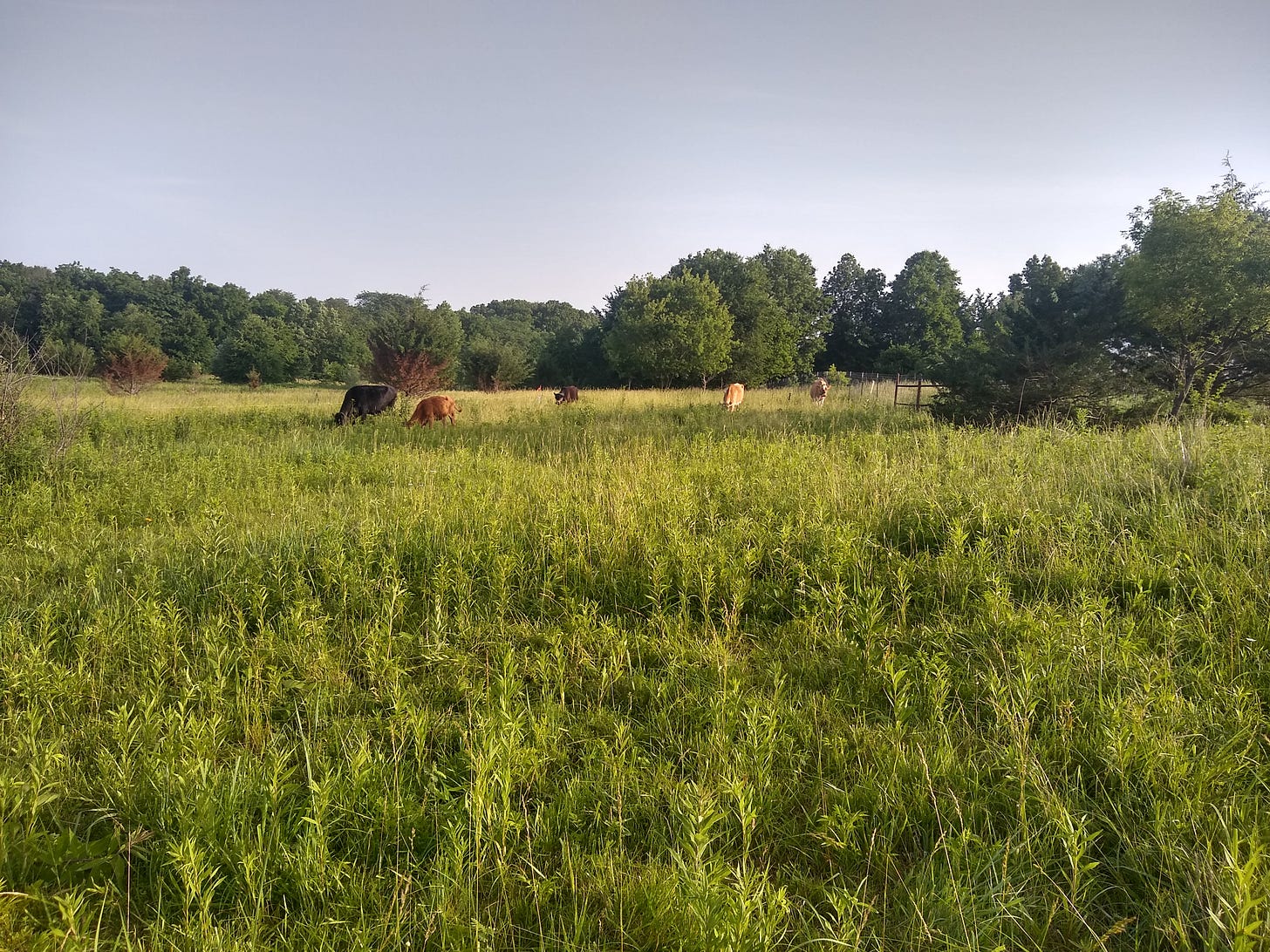
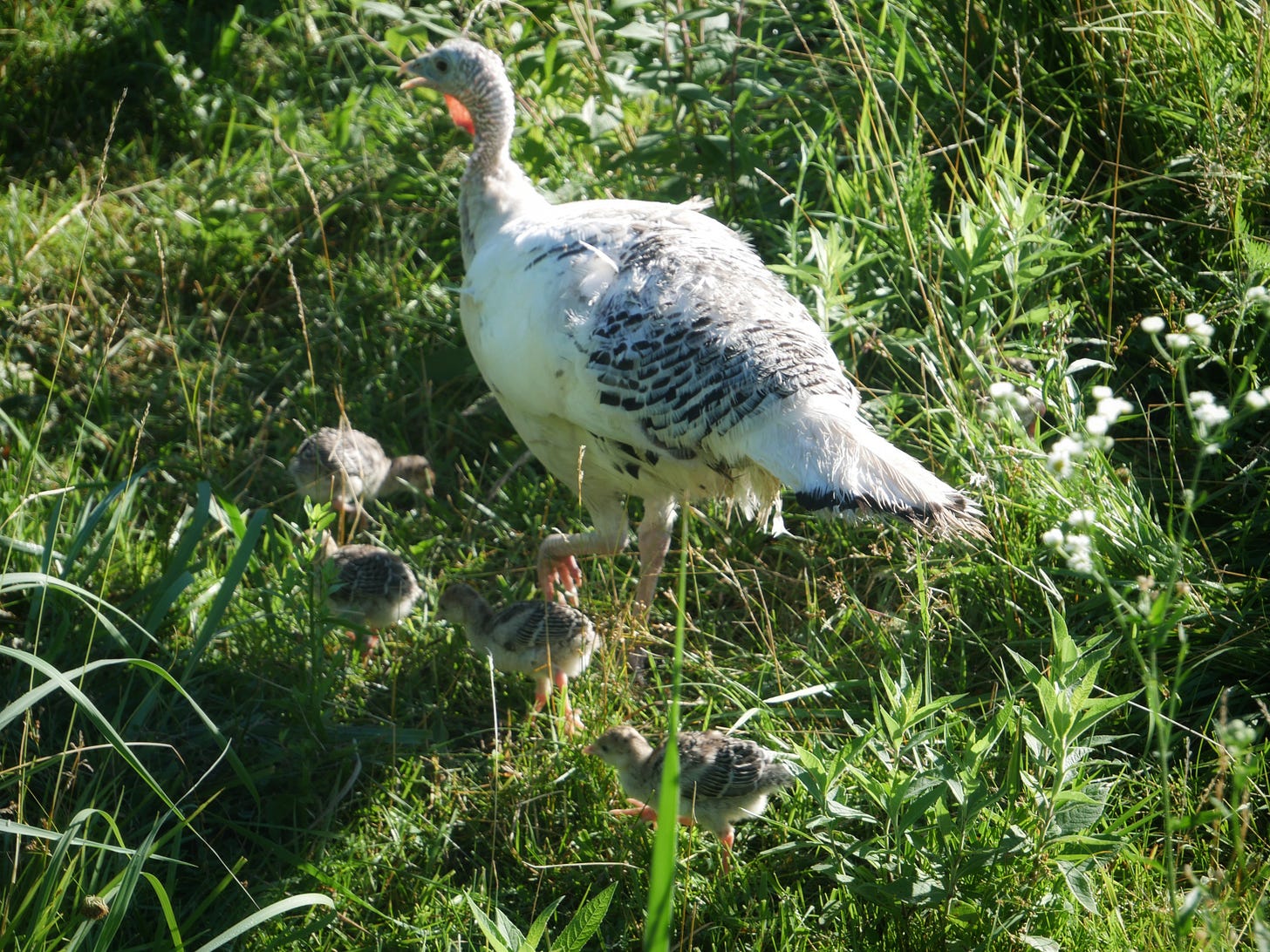
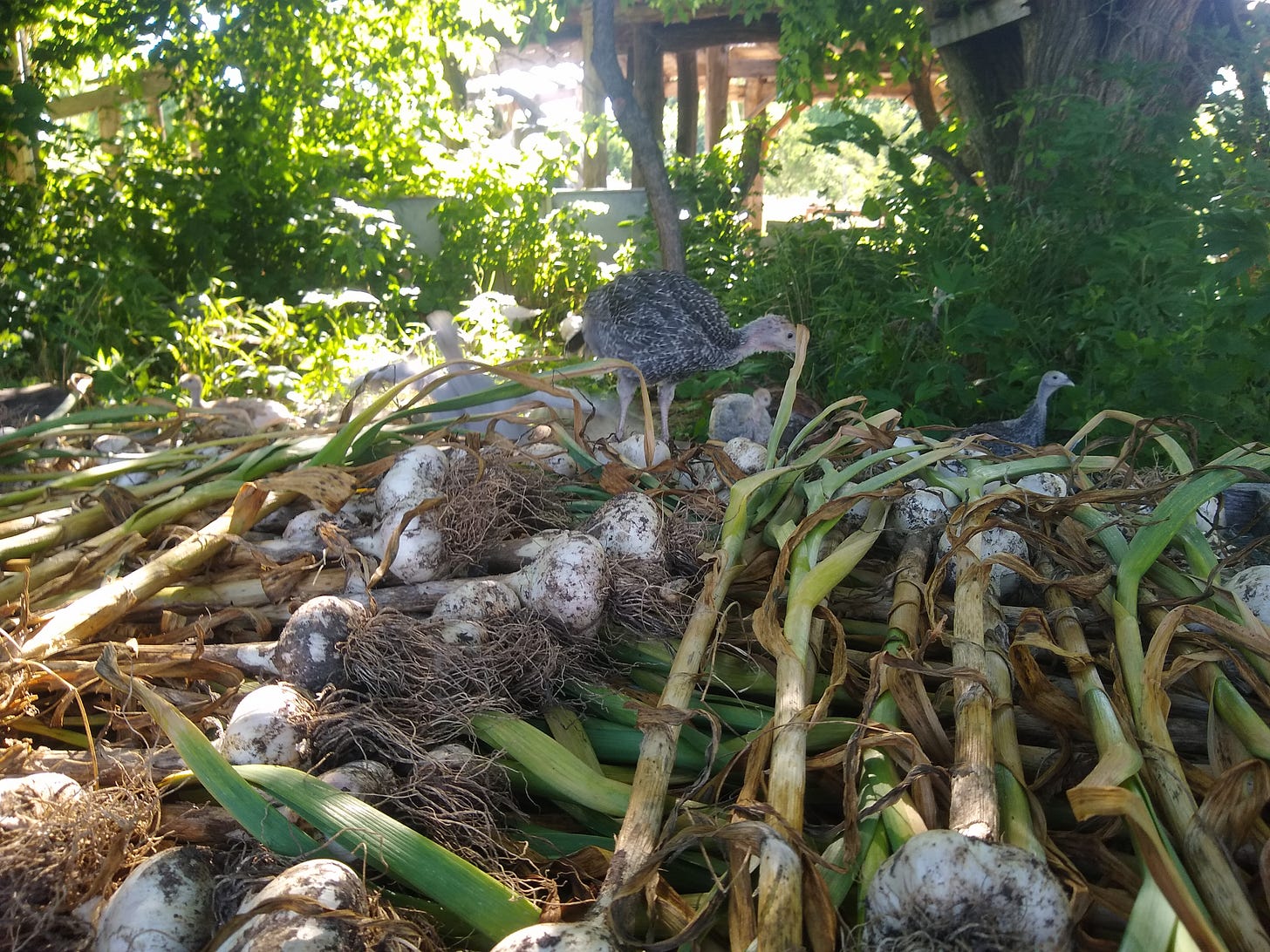

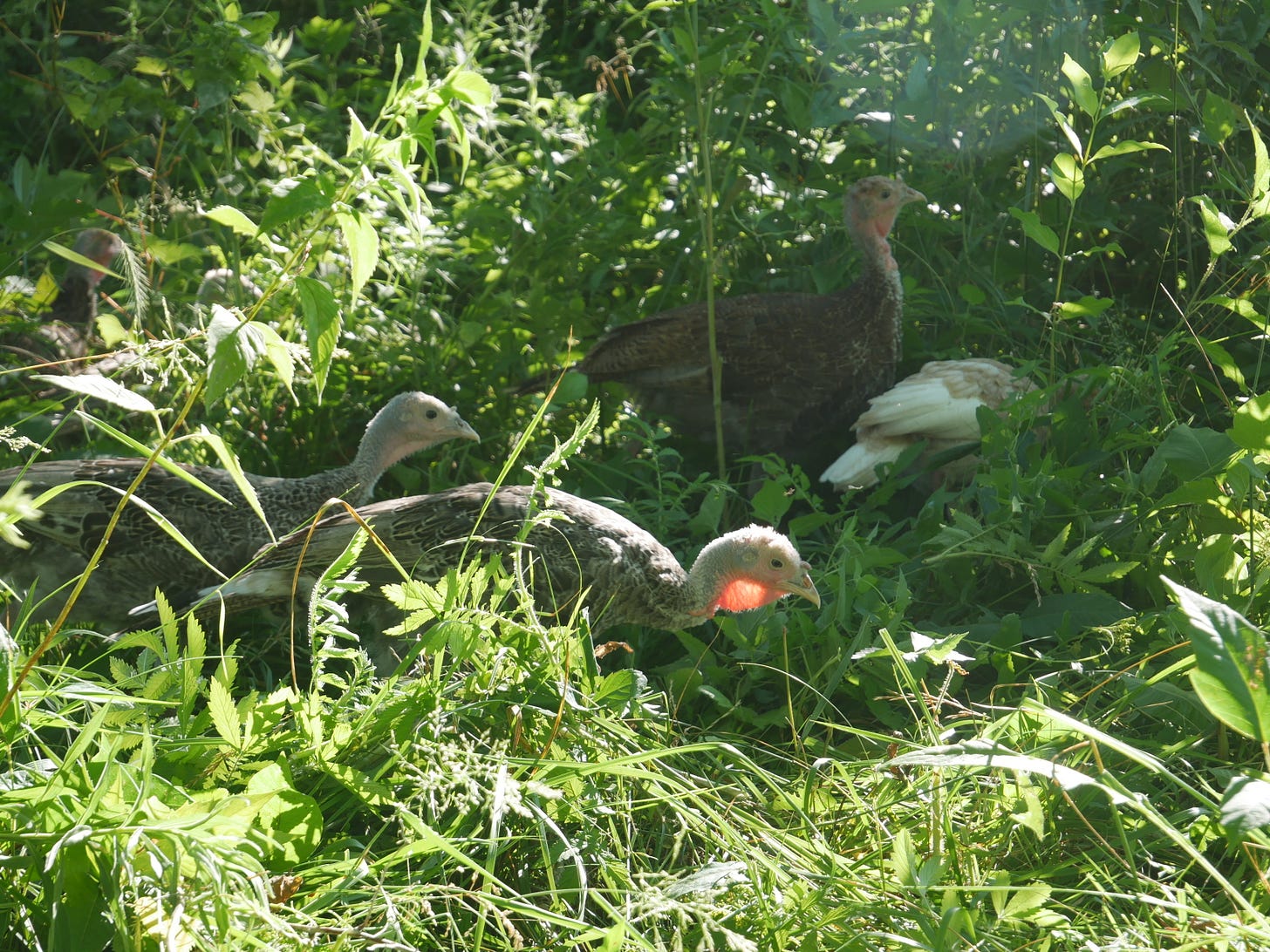
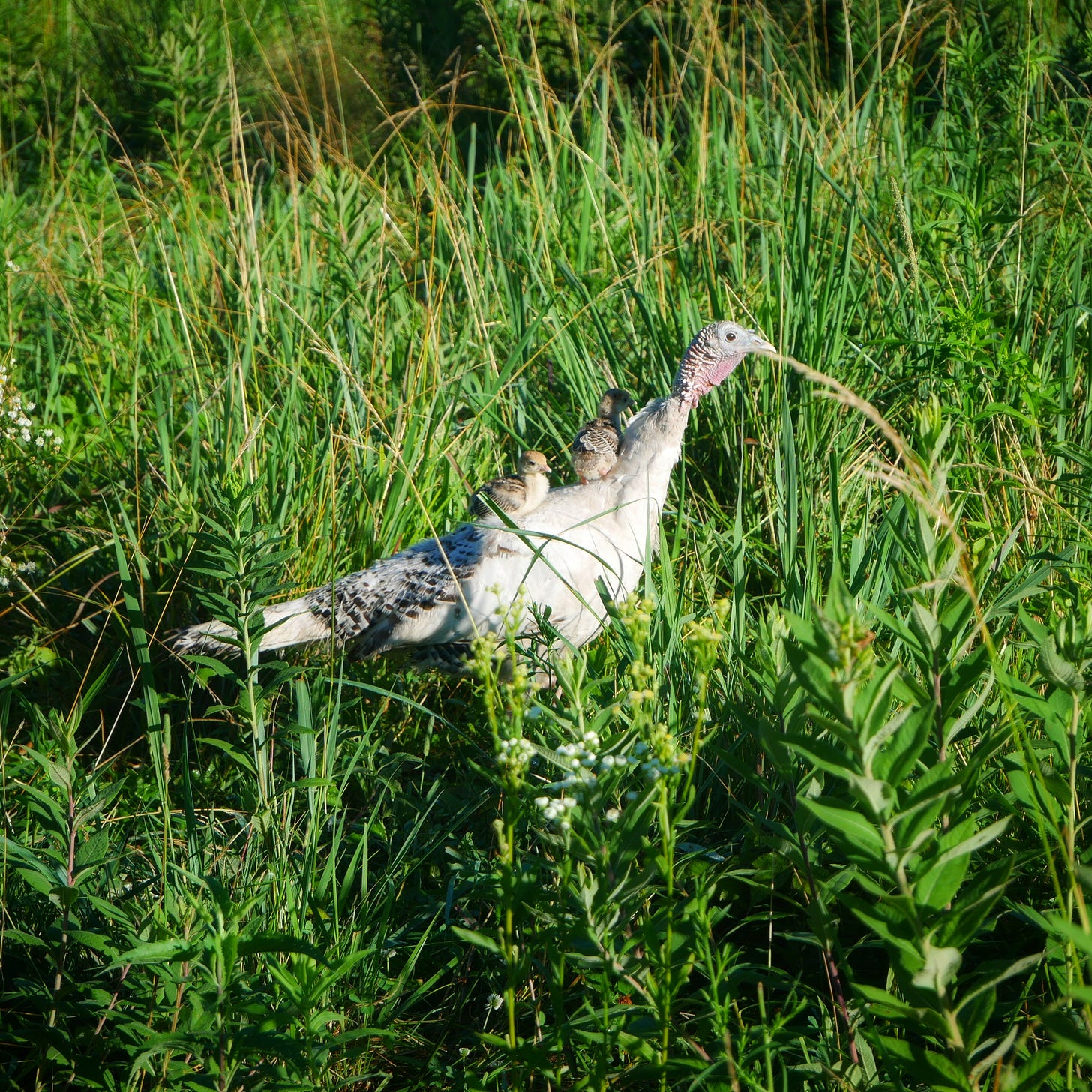
Can I ask why you don’t let them roost in trees or plant trees for them to use in the long term? I’m assuming raptor pressure, or maybe the mammal predators can climb them? Just curious, thanks. Your writing is very poetic!
What you are doing with fowl seems similar to what Daniel Firth Griffith does with cows. If you don't know of him, here is his link: https://danielfirthgriffith.substack.com/